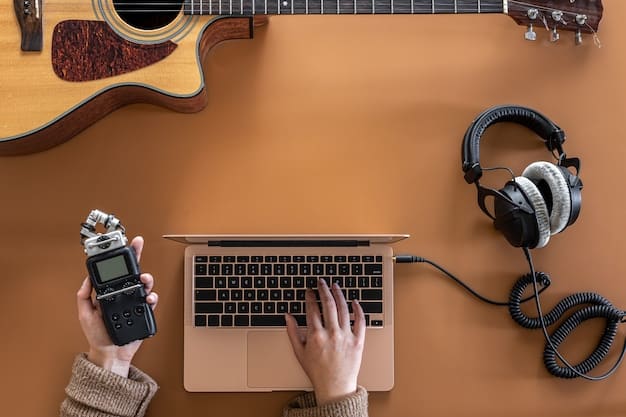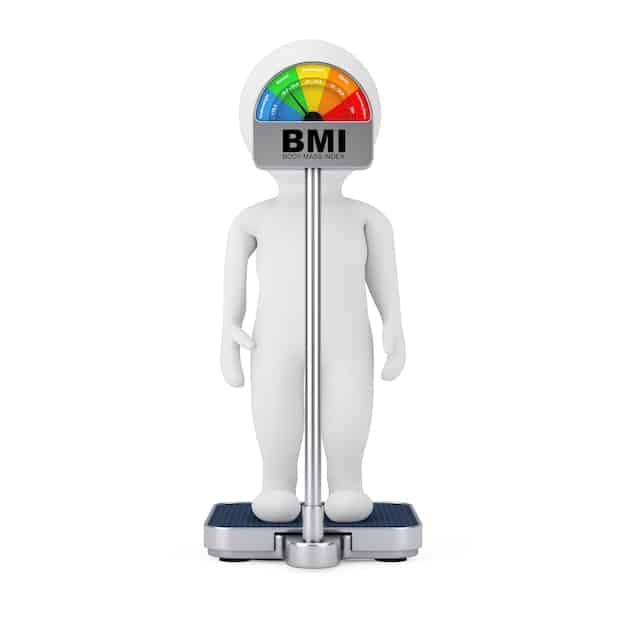Demystifying Music Royalties: Your Ultimate Guide to US Payments

Demystifying music royalties involves understanding the complex system that ensures artists and rights holders are compensated for the use of their work, covering various types of royalties such as performance, mechanical, and synchronization, each generated through different avenues like streaming, sales, and public performances in the United States.
Navigating the world of music royalties can feel like deciphering a complex code, especially for musicians in the United States. This guide aims at demystifying music royalties, providing clarity and actionable insights into how these payments work and how you can ensure you’re fairly compensated for your creative work.
Understanding the Basics of Music Royalties
Music royalties are the lifeblood of the music industry, ensuring that creators are compensated when their work is used commercially. Whether it’s through streaming, radio play, or a song featured in a movie, royalties are generated whenever music is consumed publicly. Understanding the different types of royalties and how they are collected is crucial for any musician looking to sustain a career.
What Are Music Royalties?
Music royalties are payments made to songwriters, composers, and copyright holders for the licensed use of their music. These royalties are essential for compensating artists and ensuring the continued creation of music. They provide financial support that allows musicians to invest in their craft, record new music, and reach wider audiences.
Why Are Royalties Important?
Royalties recognize and protect the intellectual property rights of musicians. They ensure that artists are compensated fairly for their work being used in various commercial settings. Without royalties, it would be difficult for musicians to earn a living from their creative endeavors, stifling the music industry’s growth and innovation.
- Royalties provide financial stability for musicians.
- They encourage continued creativity and investment in music.
- Royalties protect the intellectual property rights of artists.
- Fair compensation fuels the broader music ecosystem.
In conclusion, understanding the basics of music royalties is the first step in ensuring you receive the compensation you deserve for your creative work. Recognizing the importance of these royalties will help you navigate the complex landscape of the music industry with confidence.
Types of Music Royalties in the US
In the United States, music royalties are divided into several distinct categories, each covering different uses of a song. Understanding these categories is essential for musicians to ensure they are collecting all the royalties they are entitled to. The main types include performance royalties, mechanical royalties, and synchronization royalties.
Performance Royalties
Performance royalties are generated when a song is performed publicly. This includes radio play, live concerts, streaming services, and even when music is played in restaurants or bars. These royalties are collected by Performance Rights Organizations (PROs) such as ASCAP, BMI, and SESAC, who then distribute them to the rights holders.
Mechanical Royalties
Mechanical royalties are paid when a song is reproduced, whether physically (like CDs or vinyl) or digitally (like downloads or interactive streams). These royalties compensate the songwriter and publisher for the reproduction of their work. In the U.S., mechanical royalties are often collected and distributed by organizations like the Harry Fox Agency (HFA) and Songtrust.

Synchronization Royalties
Synchronization royalties are earned when a song is used in visual media such as movies, TV shows, commercials, and video games. These royalties require a license from both the songwriter and the publisher. The fee for synchronization licenses can vary widely depending on the popularity of the song and the scope of its use.
- Performance royalties cover public performances of songs.
- Mechanical royalties cover the reproduction of songs.
- Synchronization royalties cover the use of songs in visual media.
- Understanding these distinctions is crucial for royalty collection.
In summary, knowing the different types of music royalties and how they are generated is essential for any musician looking to maximize their earnings. Performance, mechanical, and synchronization royalties each play a unique role in compensating artists for their creative work.
Performance Rights Organizations (PROs): ASCAP, BMI, and SESAC
Performance Rights Organizations (PROs) play a crucial role in the collection and distribution of performance royalties. In the United States, the primary PROs are ASCAP, BMI, and SESAC. Each organization represents different songwriters and publishers, and it’s essential to understand their functions and how they operate.
ASCAP (American Society of Composers, Authors and Publishers)
ASCAP is a membership-based organization that collects performance royalties on behalf of its members. It licenses the public performance rights of its members’ music and distributes royalties collected from various sources such as radio, television, and live performances. ASCAP operates on a non-profit basis, distributing royalties directly to its members after deducting operating expenses.
BMI (Broadcast Music, Inc.)
BMI, like ASCAP, is a PRO that collects and distributes performance royalties to its members. It also licenses the public performance rights of its members’ music and ensures that songwriters and publishers are compensated for their work. BMI also operates on a non-profit basis, with a focus on supporting and promoting its members’ music.

SESAC (Society of European Stage Authors and Composers)
SESAC is a for-profit PRO that also collects and distributes performance royalties. Unlike ASCAP and BMI, SESAC is an invitation-only organization, representing a smaller, more selective group of songwriters and publishers. SESAC offers a range of services to its members, including royalty collection, licensing, and advocacy.
- ASCAP and BMI are non-profit, open-membership PROs.
- SESAC is a for-profit, invitation-only PRO.
- Each PRO collects and distributes performance royalties.
- Choosing the right PRO is crucial for royalty collection.
In essence, understanding the roles of ASCAP, BMI, and SESAC is crucial for any musician looking to collect performance royalties. These organizations serve as intermediaries, ensuring that artists are compensated when their music is performed publicly.
Mechanical Licensing and the Harry Fox Agency (HFA)
Mechanical licensing is a critical aspect of music royalties, dealing with the reproduction and distribution of musical works. The Harry Fox Agency (HFA) plays a central role in this process, acting as a licensing and collection agency for mechanical royalties in the United States. Understanding the intricacies of mechanical licensing and HFA is essential for musicians and publishers alike.
Mechanical licensing involves obtaining permission to reproduce and distribute a song in various formats, including physical copies (like CDs and vinyl), digital downloads, and interactive streams. This ensures that songwriters and publishers are compensated for each reproduction of their work. The royalty rates for mechanical licenses are typically set statutorily, providing a predictable framework for payments.
The Harry Fox Agency (HFA) is a leading provider of mechanical licensing, collection, and distribution services in the United States. It represents a large number of music publishers, allowing businesses to easily obtain the necessary licenses for reproducing their songs. HFA also offers tools and resources for tracking and managing mechanical royalties.
Understanding mechanical licensing and the role of the Harry Fox Agency (HFA) is vital for ensuring you are correctly compensated for the reproduction of your musical works. Properly navigating the mechanical licensing process can significantly impact your income and protect your rights as a creator.
Synchronization Licenses: Getting Your Music into Film and TV
Synchronization licenses enable the use of your music in visual media like films, TV shows, commercials, and video games. Obtaining a synchronization license involves negotiating with both the music publisher (who controls the composition) and the record label (who controls the sound recording). These licenses can be a significant source of revenue for musicians.
Negotiating Sync Licenses
Negotiating a sync license can be complex, with fees varying widely depending on the popularity of the song, the prominence of its use in the visual media, and the scope of the project. Factors such as the duration of the song used, the territory of distribution, and the type of media all influence the licensing fee. It’s essential to understand these factors to negotiate effectively.
The Role of Music Supervisors
Music supervisors play a crucial role in the synchronization process. They are responsible for selecting and licensing music for films, TV shows, and other visual media. Building relationships with music supervisors can increase your chances of getting your music placed in these projects. They can advise on the suitability and availability of your music for various projects.
Tips for Securing Sync Licenses
Securing sync licenses requires a proactive approach. First, ensure your music is easily discoverable and properly tagged with relevant metadata. Second, consider working with a music licensing agency that specializes in sync placements. Finally, be prepared to negotiate and be flexible with your licensing fees to secure the opportunity.
- Negotiating sync licenses involves multiple factors.
- Music supervisors are key decision-makers in music placement.
- Preparation and networking increase your chances of success.
In conclusion, securing synchronization licenses can open up significant opportunities for your music to reach wider audiences and generate substantial income. Understanding the negotiation process, building relationships with music supervisors, and proactively promoting your music are all essential steps in achieving success in the world of sync licensing.
Collecting Your Royalties: A Step-by-Step Guide
Collecting your music royalties involves several key steps, from registering your songs with the appropriate organizations to tracking your earnings and ensuring accurate payouts. This step-by-step guide will help you navigate the process and maximize your royalty income. The first step is to register your music with Performance Rights Organizations (PROs) such as ASCAP, BMI, or SESAC to collect performance royalties.
Registering Your Music
Registering your songs with PROs ensures that you receive performance royalties whenever your music is played publicly. Each PRO has its own registration process, but typically involves providing information about the song’s title, composer, and publisher. Make sure to keep your registration information up to date to avoid any delays in royalty payments.
Tracking Your Earnings
Tracking your music earnings is crucial for ensuring you are receiving the correct royalty payments. Utilize online tools and resources provided by PROs and other royalty collection agencies to monitor your earnings from various sources. Keep detailed records of your music’s usage and compare them against your royalty statements.
Ensuring Accurate Payouts
Ensuring accurate royalty payouts requires vigilance and attention to detail. Review your royalty statements carefully and compare them against your own records. If you identify any discrepancies, contact the relevant royalty collection agency to investigate and resolve the issue. Consider consulting with a music industry professional or attorney to help you navigate complex royalty issues.
- Register your music with PROs to collect performance royalties.
- Track your earnings using online tools and resources.
- Ensure accurate payouts by reviewing royalty statements carefully.
- Consider professional help for complex royalty issues.
To summarize, collecting your music royalties involves registering your music, tracking your earnings, and ensuring accurate payouts. By taking these steps, you can effectively navigate the complex world of music royalties and maximize your income as a musician.
Common Mistakes and How to Avoid Them
Navigating the world of music royalties can be challenging, and it’s easy to make mistakes that could cost you money. This section outlines some common pitfalls and provides practical advice on how to avoid them.
One of the most common mistakes is failing to register your songs with Performance Rights Organizations (PROs) like ASCAP, BMI, or SESAC. Without registration, you won’t receive performance royalties when your music is played publicly. To avoid this, register your songs as soon as they are written.
Another mistake is neglecting to track your earnings. It’s essential to monitor your royalty statements and compare them against your own records to ensure you are receiving accurate payouts. Use online tools and resources provided by PROs to track payments.
Neglecting to obtain synchronization licenses for the use of your music in visual media is another one of the common mistakes. Ensure and obtain the needed licenses to avoid legal repercussions.
- Failing to register songs with PROs.
- Not tracking music earnings.
- Neglecting to obtain synchronization licenses.
| Key Point | Brief Description |
|---|---|
| 🎵 Register with PROs | Join ASCAP, BMI, or SESAC to collect performance royalties. |
| 📄 Understand Licenses | Know the differences between mechanical, performance, and sync licenses. |
| 📊 Track Earnings | Monitor royalty statements to ensure accurate payouts. |
| 🤝 Negotiate Syncs | Secure synchronization licenses for music in visual media. |
FAQ Section
▼
Performance royalties are generated when your music is played publicly, whether that’s on the radio, in a club, or streamed online. These royalties compensate you for the public performance of your work.
▼
To register, visit the website of a Performance Rights Organization (PRO) like ASCAP, BMI, or SESAC, fill out their membership application, and provide details about your songs and compositions.
▼
A mechanical license grants the rights to reproduce and distribute copyrighted musical compositions, whether it’s through physical copies, digital downloads, or interactive streaming platforms.
▼
Synchronization licenses are required to use your music with visual media such as films, television shows, commercials, or video games, ensuring you are compensated for the synchronizing of your song.
▼
Track your royalties through the online portals provided by your PROs and collection agencies, comparing earnings against your own records, thus ensuring accurate royalty payments and identifying any discrepancies.
Conclusion
Understanding the complexities of music royalties is vital for any musician aiming to earn compensation for their creative work. By grasping the different types of royalties, registering with PROs, and staying informed about licensing, you can protect your rights and maximize your income in the music industry.





